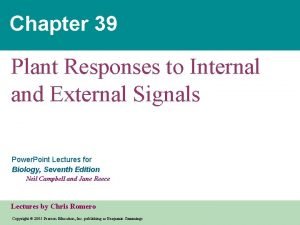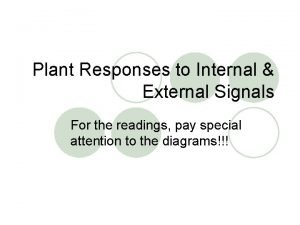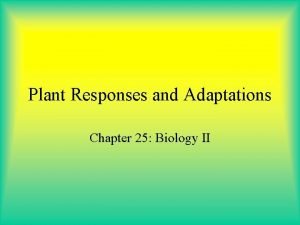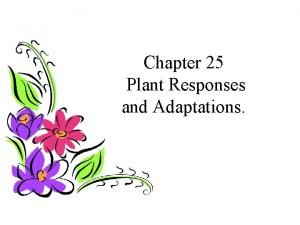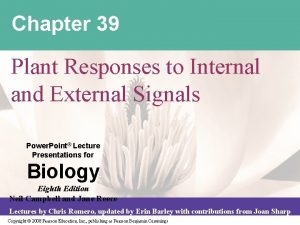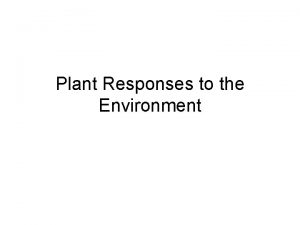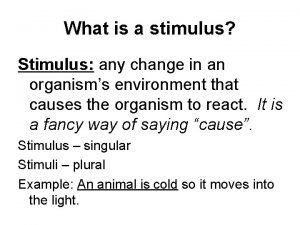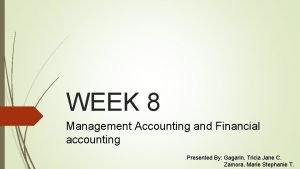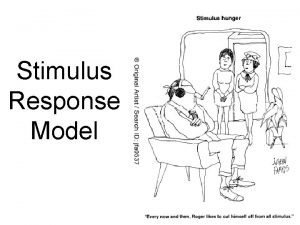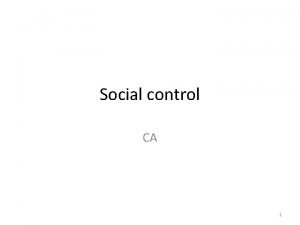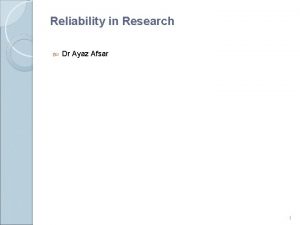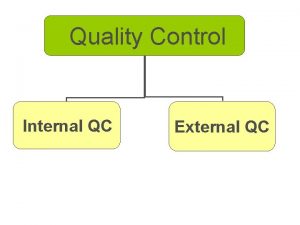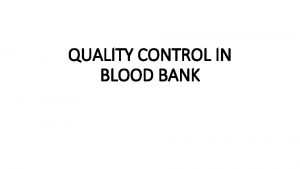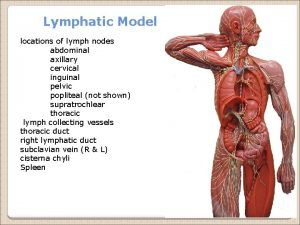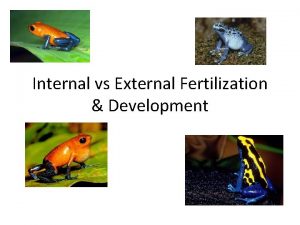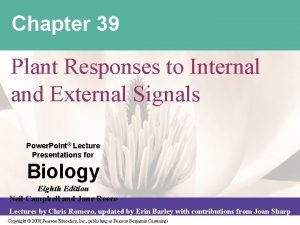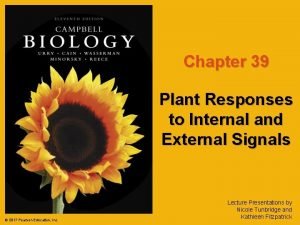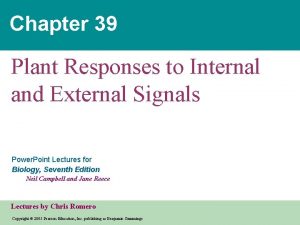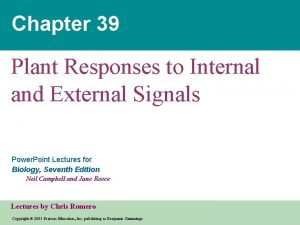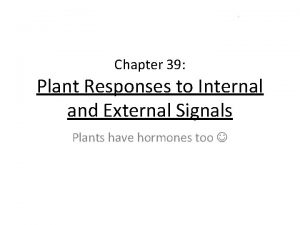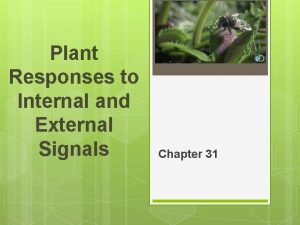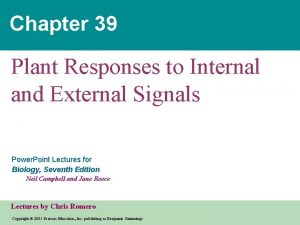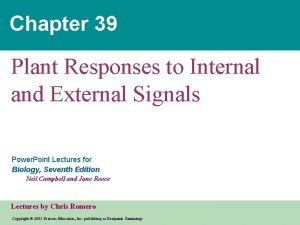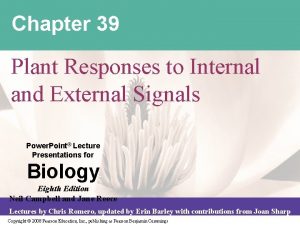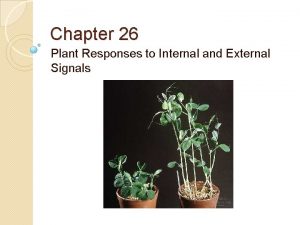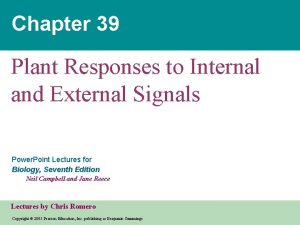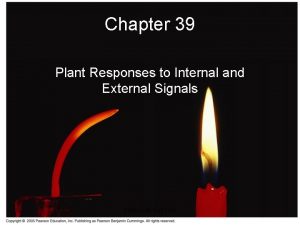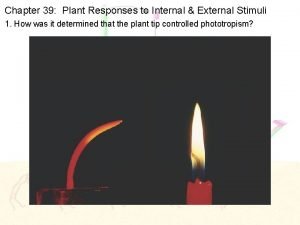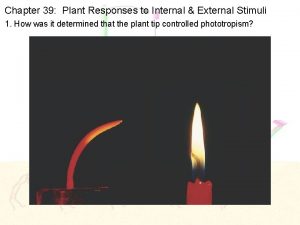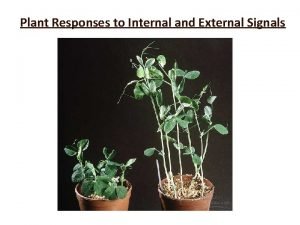Chapter 39 Plant Responses to Internal and External























- Slides: 23

Chapter 39: Plant Responses to Internal and External Signals 39. 2 Admit Slip 3. List 3 words you think of when you look at the picture/diagram 2. Write 2 ideas you have based on the picture and your words. If possible, use your words as you write your ideas. 1. Write 1 question you have.

Hormones • Plant hormones help coordinate growth, development, and responses to stimuli – Hormones: chemical messengers that coordinate the different parts of a multicellular organism (produced in one location and transported to another in the body)

Tropism • A plant growth response from hormones that results in the plant growing either toward or away from a stimulus – Phototropism: growth of a shoot in a certain direction in response to light • Positive phototropism: growth toward light • Negative phototropism: growth away from light


Greening response to light in potatoes

Types of hormones • • • Auxin Cytokinins Gibberellins Abscisic acid ethylene

AUXINS • Natural auxin in plants is idoleacetic acid (IAA) • Plays a key role in phototropisms and gravitropisms • Stimulate elongation of cells in young shoots – Produced in apical meristems and activate proton pumps in plasma membrane (lowers p. H) – Cell wall is weakened, turgor pressure expands cell wall=cell elongation Apical dominace: apical bud (left) apical bud removed (right)

How Auxins Cause Cell Elongation • Increase in H+ activates expansins • Weakened cell wall allows more water to enter H+ pump

Synthetic Auxins • Used as herbicides – Monocots (grasses) can quickly inactivate synthetic auxins but dicots cannot – High concentrations therefore kill broadleaf (dicot) weeds while grasses (like corn and turf grass) are not harmed

Other Hormones • Cytokinins: stimulate cytokinesis or cell division (aide in growth). Work with auxins to stimulate cell division and differentiation • Gibberellins: work with auxins to stimulate cell elongation by loosening cell walls, allowing for expansion of cells and stems. Effects: fruit growth, stem elongation, seed germination

Other Hormones • Abscisic Acid: slows growth , promotes seed dormancy, drought tolerance (water stress=close stomata to save water) • Ethylene: gas, role in programmed cell death (apoptosis) such as shedding of leaves/death of annual after flowering. Promotes ripening of fruits which triggers more ethylene (positive feedback loop)-1 rotten apple can spoil the bunch…


Went Experiments

Chapter 39: Plant Responses to Internal and External Signals 39. 3

Plants and Light • Plants detect presence, direction, intensity, and wavelength of light • Red and blue light are the most important to plants – Blue-light receptors initiate plant response such as phototropisms and opening of stomata – Red-light receptors=Phytochromes


Phytochrome photoreceptors • Molecular switch reaction to red light – conversion of Pr Pfr in sunlight stimulates germination, flowering, branching… – conversion of Pfr Pr in dark inhibits response, & stimulates other responses: growth in height Light induced Chromophore Photorecptor Kinase activity Phytochrome Response: Vertical growth 2007 -2008

Practical Application • Why do you plant lettuce seed by scattering them on the ground instead of burying seed? • What is the evolutionary advantage to lettuce seeds? 2007 -2008

Phytochromes and Circadian Rhythyms • Circadian Rhythms: physiological clocks that usually run on a 24 hour cycle (not paced on environmental cues) • Surge of Pfr at dawn resets clock • Combination of phytochrome system and biological clock allow plant to asses the amount of daylight/darkness and time of year

Photoperiodism • Photoperiod: relative length of night and day • A physiological response (such as flowering) to a photoperiod=photoperiodism • Controls when plants flower • Length of night is more critical than length of day – Old terminology remains!! We refer to plants by day-length!

Day-length Plants • Short-day plants: require a period of continuous darkness longer than a critical period to flower. – Flower in early spring or fall – Actually ‘Long-night” plants • Long-day plants: require a period of continuous darkness sorter than critical period to flower – Flower in late spring/early summer – Actually “short-night” plants • Day-neutral plants: flower in days of any length

Figure 39. 22 Photoperiodic control of flowering

Figure 39. 23 Reversible effects of red and far-red light on photoperiodic response
 Seed germination
Seed germination Plant responses to internal and external signals
Plant responses to internal and external signals Chapter 25 plant responses and adaptations answer key
Chapter 25 plant responses and adaptations answer key Positive geotropism
Positive geotropism Respond to
Respond to Plant hormones and responses
Plant hormones and responses Plant and animal responses
Plant and animal responses Accounting information system chapter 1
Accounting information system chapter 1 Chapter 10 stress responses and stress management
Chapter 10 stress responses and stress management Parts of a plant foldable
Parts of a plant foldable Examples of external stimuli
Examples of external stimuli External and internal users of accounting information
External and internal users of accounting information Internal stakeholders
Internal stakeholders Flow chart of stimulus response
Flow chart of stimulus response Nature of social control
Nature of social control Internal and external factors of nationalism
Internal and external factors of nationalism Internal and external reliability
Internal and external reliability Internal qc
Internal qc Quality assurance in blood bank
Quality assurance in blood bank Stakeholders internal and external
Stakeholders internal and external Transversus abdominis
Transversus abdominis Internal and external issues template
Internal and external issues template 8051 timer interrupt programming in assembly language
8051 timer interrupt programming in assembly language Internal vs external fertilisation
Internal vs external fertilisation
